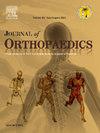曾有伸肌功能障碍的患者接受全膝关节置换术后的并发症:回顾性综述
IF 1.5
Q3 ORTHOPEDICS
引用次数: 0
摘要
背景全膝关节置换术(TKA)后伸肌机制中断是一种罕见但严重的并发症。虽然理论上髌骨异常是这一并发症的一个风险因素,但很少有文献描述先前的伸肌机构功能障碍(EMD)对 TKA 术后这一并发症和其他并发症的影响。在本研究中,我们介绍了本机构在 EMD 后进行 TKA 后并发症方面的经验。方法确定了在 2007 年 4 月至 2023 年 4 月期间接受全膝关节置换术的 61 例膝关节,这些患者都曾接受过 EMD。外展机制功能障碍类型包括髌骨骨折、髌骨肌腱断裂、髌骨复位手术、既往髌骨脱位以及影响外展机制功能的慢性髌骨侧移。主要结果包括外展机制失效、感染、脱位、无菌性松动、翻修手术和需要麻醉下操作(MUA)的僵硬。15名患者出现并发症,总并发症发生率为24.6%。有1例伸肌机制破坏,表现为部分股四头肌腱撕裂,需要进行修复。有一次髌骨脱位需要再次手术。有五例表皮感染在非手术治疗下成功治愈,四例深部感染需要再次手术。共进行了九次再手术,其中四次是翻修手术。结论 在这项研究中,我们发现曾有伸肌机制功能障碍的患者在TKA术后并发症发生率很高。有一例股四头肌肌腱部分断裂,需要进行修复。本文章由计算机程序翻译,如有差异,请以英文原文为准。
Complications following total knee arthroplasty in patients with prior extensor mechanism dysfunction: A retrospective review
Background
Extensor mechanism disruption following total knee arthroplasty (TKA) is a rare, yet serious complication. While previous patellar abnormalities are a theoretical risk factor for this complication, there is a scarcity of literature describing the impact of prior extensor mechanism dysfunction (EMD) on this and other complications following TKA. In this study, we describe our institutional experience with complications following TKA after EMD.
Methods
Sixty-one knees that underwent total knee arthroplasty between April 2007 and April 2023 in patients with previous EMD were identified. Extensor mechanism dysfunction types included patellar fracture, patellar tendon rupture, patellar realignment surgery, previous patellar dislocation, and a chronic laterally tracking patella impacting extensor mechanism function. Primary outcomes included extensor mechanism failure, infection, dislocation, aseptic loosening, revision surgery, and stiffness requiring manipulation under anesthesia (MUA).
Results
A total of 61 knees, comprised of 53-patients, were included. There were complications witnessed in fifteen patients, leading to a 24.6 % overall complication rate. There was one extensor mechanism disruption in the form of a partial quadriceps tendon tear requiring repair. There was one patellar dislocation requiring reoperation. There were five superficial infections successfully treated non-operatively and four deep infections requiring reoperation. A total of nine reoperations were performed, four of which were revisions. Four patients underwent MUA due to severe post-operative stiffness.
Conclusion
In this study, we found a high complication rate following TKA in patients with previous extensor mechanism dysfunction. There was one case of partial quadriceps tendon rupture requiring repair.
求助全文
通过发布文献求助,成功后即可免费获取论文全文。
去求助
来源期刊

Journal of orthopaedics
ORTHOPEDICS-
CiteScore
3.50
自引率
6.70%
发文量
202
审稿时长
56 days
期刊介绍:
Journal of Orthopaedics aims to be a leading journal in orthopaedics and contribute towards the improvement of quality of orthopedic health care. The journal publishes original research work and review articles related to different aspects of orthopaedics including Arthroplasty, Arthroscopy, Sports Medicine, Trauma, Spine and Spinal deformities, Pediatric orthopaedics, limb reconstruction procedures, hand surgery, and orthopaedic oncology. It also publishes articles on continuing education, health-related information, case reports and letters to the editor. It is requested to note that the journal has an international readership and all submissions should be aimed at specifying something about the setting in which the work was conducted. Authors must also provide any specific reasons for the research and also provide an elaborate description of the results.
 求助内容:
求助内容: 应助结果提醒方式:
应助结果提醒方式:


